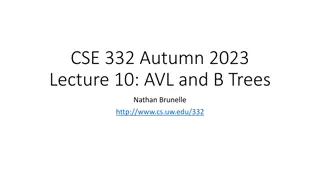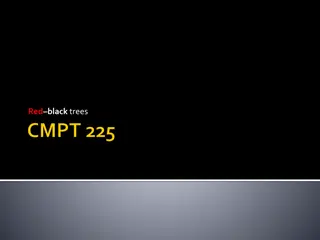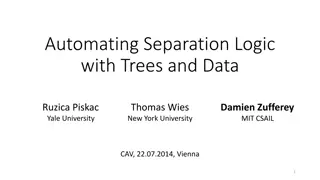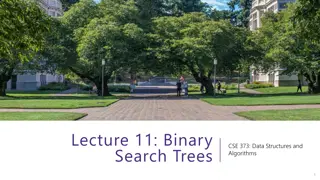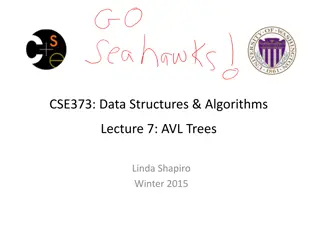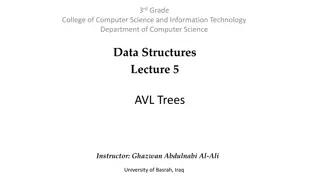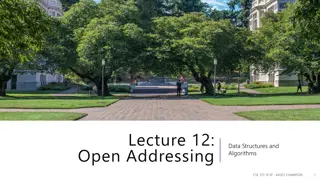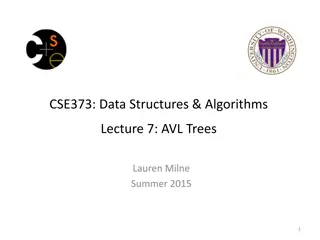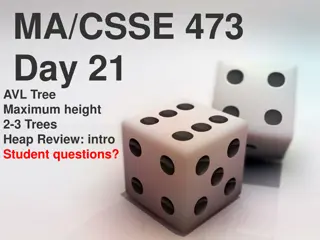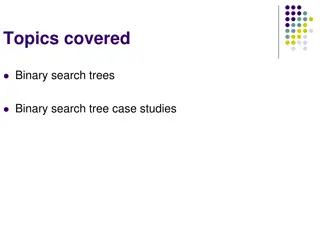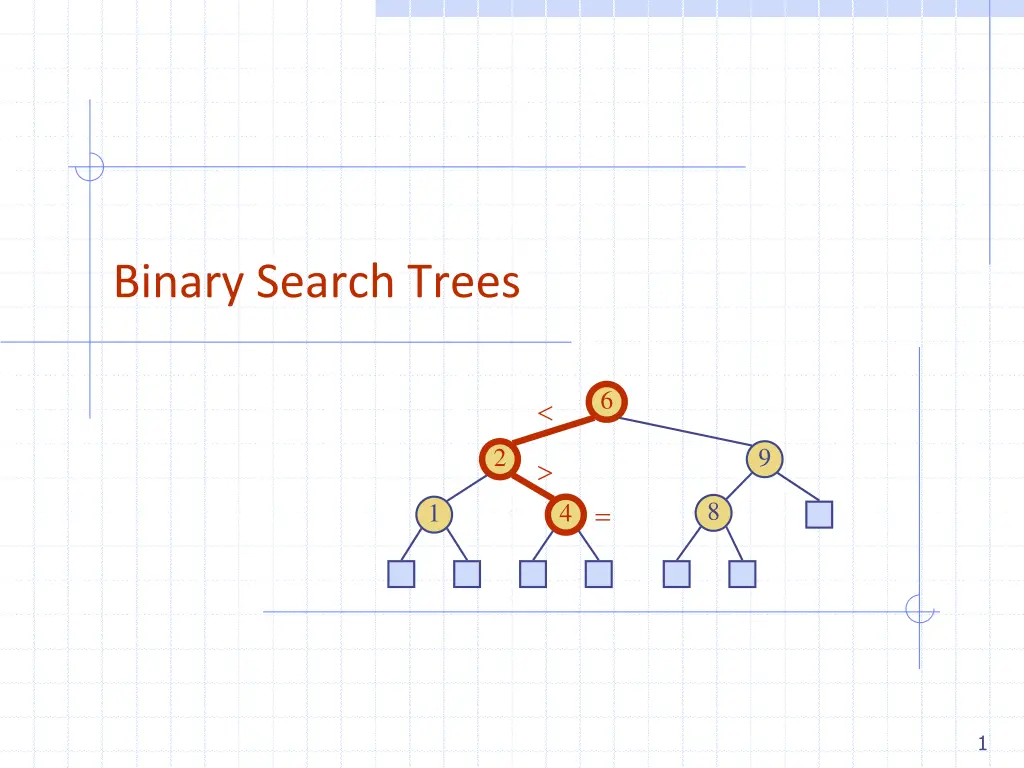
Binary Search Trees and Search Tables Overview
Explore the concepts of binary search trees and search tables, including their implementation, performance, and operations like get, floorEntry, and ceilingEntry. Learn how binary search can efficiently search and recall ordered maps. Understand the structure of binary search trees and the search process involved.
Download Presentation

Please find below an Image/Link to download the presentation.
The content on the website is provided AS IS for your information and personal use only. It may not be sold, licensed, or shared on other websites without obtaining consent from the author. If you encounter any issues during the download, it is possible that the publisher has removed the file from their server.
You are allowed to download the files provided on this website for personal or commercial use, subject to the condition that they are used lawfully. All files are the property of their respective owners.
The content on the website is provided AS IS for your information and personal use only. It may not be sold, licensed, or shared on other websites without obtaining consent from the author.
E N D
Presentation Transcript
Binary Search Trees 6 2 9 = 8 1 4 1
Recall: Ordered Maps Keys come from a total order New operations: Each returns an iterator to an entry: firstEntry(): smallest key in the map lastEntry(): largest key in the map floorEntry(k): largest key k ceilingEntry(k): smallest key k All return end if the map is empty 2
Binary Search Binary search can perform operations get, floorEntry and ceilingEntry on an ordered map implemented by means of an array-based sequence, sorted by key similar to the high-low game at each step, the number of candidate items is halved terminates after O(log n) steps Example: find(7) 0 l 1 3 4 5 7 8 9 11 14 16 18 19 h m 0 l 1 3 4 5 7 h 8 9 11 14 16 18 19 m 0 1 3 4 l 5 7 h 8 9 11 14 16 18 19 m 0 1 3 4 5 7 8 9 11 14 16 18 19 l=m =h 3
Search Tables A search table is an ordered map implemented by means of a sorted sequence We store the items in an array-based sequence, sorted by key We use an external comparator for the keys (for any arbitrary comparison) Performance: get, floorEntry and ceilingEntry take O(log n) time, using binary search get takes O(n) time since in the worst case we have to shift n 2 items to make room for the new item erase take O(n) time since in the worst case we have to shift n 2 items to compact the items after the removal 4
Binary Search Trees A binary search tree is a binary tree storing keys (or key-value entries) at its internal nodes and satisfying the following property: Let u, v, and w be three nodes such that u is in the left subtree of v and w is in the right subtree of v. We have key(u) key(v) key(w) An inorder traversal of a binary search trees visits the keys in increasing order 6 2 9 1 4 8 External nodes do not store items 5
Search To search for a key k, we trace a downward path starting at the root The next node visited depends on the comparison of k with the key of the current node If we reach a leaf, the key is not found Example: get(4): AlgorithmTreeSearch(k, v) ifv.isExternal () returnv if k v.key() returnTreeSearch(k, v.left()) else if k=v.key() returnv else { k v.key() } returnTreeSearch(k, v.right()) Call TreeSearch(4,root) The algorithms for floorEntry and ceilingEntry are similar 6 2 9 = 8 1 4 Recursive 6
Insertion Example: insert(5) To perform operation put(k, o), we search for key k (using TreeSearch) 6 2 9 1 4 8 Assume k is not already in the tree, and let w be the leaf reached by the search w 6 We insert k at node w and expand w into an internal node 2 9 1 4 8 w 5 7
Deletion Example: remove 4 To perform operation erase(k), we search for key k 6 2 9 Assume key k is in the tree, and let v be the node storing k v 1 4 8 w 5 Basic method removeAboveExternal(w): removes w and its parent 6 If node v has a leaf child w, we remove v and w from the tree with removeAboveExternal(w) 2 9 1 5 8 What about remove 1 ? 8
Deletion (cont.) Example: remove 3 Key k to be removed is stored at a node v whose children are both internal 1 v 3 2 8 1. Find the internal node w that follows v in an inorder traversal (find the smallest w larger than v) 2. Copy key(w) into node v 3. Remove node w and its left child z (which must be a leaf) by means of operation removeExternal(z) 6 9 w 5 z 1 v 5 2 8 Why left child z? 6 9 No other cases? 9
Performance Consider an ordered map with n items implemented by a binary search tree of height h Space: O(n) methods get, floorEntry, ceilingEntry, put and erase take O(h) time The height h is O(n) in the worst case and O(log n) in the best case Question: Can we find the algorithm with worst-case O(log n) Idea??? Balancing 10
AVL Trees 6 v 8 3 z 4 Adelson-Velskii, G.; E. M. Landis (1962). "An algorithm for the organization of information" . Proceedings of the USSR Academy of Sciences 146: 263 266. (Russian) English translation by Myron J. Ricci in Soviet Math. Doklady, 3:1259 1263, 1962. 11
AVL Tree Definition An AVL Tree T is a binary search tree with the following property Height-Balance: For every internal node v of T, the heights of the children of v can differ by at most 1 4 44 2 3 17 78 1 2 1 88 32 50 This tree seems to be well-balanced 1 1 48 62 Height: O(log n) 12
Height of an AVL Tree (1) Fact: The height of an AVL tree storing n keys is O(log n). Proof n(h): the minimum number of internal nodes of an AVL tree of height h. Easily see that n(1) = 1 and n(2) = 2 For h > 2, an AVL tree of height h and the minimum number of nodes contains (i) the root node, (ii) one AVL subtree of height h-1 and (iii) another AVL subtree of height h-2. That is, n(h) = 1 + n(h-1) + n(h-2) Knowing n(h-1) > n(h-2), we get n(h) > 2n(h-2). So n(h) > 2n(h-2), n(h) > 4n(h-4), n(h) > 8n(n-6), (by induction), n(h) > 2in(h-2i) n(2) 3 n(1) 4 13
Height of an AVL Tree (2) n(h) > 2n(h-2), n(h) > 4n(h-4), n(h) > 8n(n-6), (by induction), n(h) > 2in(h-2i) (for any integer i, such that h-2i 1) We pick i so that h-2i = 1 or 2 (base case) Then, we have Taking logarithms: h < 2log n(h) +2 Thus, the height of an AVL tree is O(log n) n(2) 3 n(1) 4 14
Insertion Insertion is as in a binary search tree Always done by expanding an external node. Example of insertion 54. What s the problem? 44 44 17 78 17 78 32 50 88 32 50 88 48 62 48 62 54 before insertion 54 after insertion 54 15
Rebalancing Needed How should we do this? (1) Take some examples (2) Find difference cases (3) Make each sub-algorithm for each case (4) Make an entire algorithm (5) Run it with some inputs (6) Find out it is not working perfectly, and say What the hell is this? How should I do? Lessons Let s summarize them later 16
Rebalancing Example: Insertion of w=54 unbalanced Search-and-Repair strategy z: first node we encounter in going up from w toward the root such that z is unbalanced y: the child of z with higher height (note that y must be an ancestor of w) x: the child of y with higher height (there cannot be a tie and node x must be an ancestor of w) What are we doing for balancing? Can we do this systematically? What are other cases? balanced 17
Please remember the notations! z, y, z z: first node we encounter in going up from w toward the root such that z is unbalanced w , balance y: the child of z with higher height x: the child of y with higher height ( ) Rename x,y,z as a,b,c so that a precedes b and b precedes c in inorder traversal We can make many combinations 18
4 Combinations inorder: z,y,x inorder: x,y,z inorder: z,x,y inorder: y,x,z 19
Restructuring (as Single Rotations) Single Rotations: Left rotation about z a = z b = y single rotation b = y a = z c = x c = x T0 T3 T1 T3 T0 T1 T2 T2 Right rotation about z c = z b = y single rotation b = y a = x c = z a = x T3 T3 T0 T2 T2 T1 T0 T1 20
Restructuring (as Double Rotations) Right rotation about y and left rotation about z double rotations: double rotation a = z b = x c = y a = z c = y b = x T0 T2 T3 T0 T1 T3 T2 T1 Left rotation about y and right rotation about z double rotation c = z b = x a = y a = y c = z b = x T0 T2 T3 T3 T1 T0 T2 21 T1
Removal Removal begins as in a binary search tree, which means the node removed (after copying the in-order successor) will become an empty external node. Its parent, w, may cause an imbalance. Example: 44 44 17 62 17 62 32 50 78 50 78 88 88 48 54 48 54 before deletion of 32 after deletion 22
Rebalancing after a Removal Let z be the first unbalanced node encountered while travelling up the tree from w. Also, let y be the child of z with the larger height, and let x be the child of y with the larger height We perform restructure(x) to restore balance at z a=z 62 44 44 78 w b=y 17 62 17 50 88 c=x 50 78 48 54 88 48 54 What happens if z is an internal node, not the root? As this restructuring may upset the balance of another node higher in the tree, we must continue checking for balance until the root of T is reached 23
AVL Tree Performance a single restructure takes O(1) time using a linked-structure binary tree find takes O(log n) time height of tree is O(log n), no restructures needed put takes O(log n) time initial find is O(log n) Restructuring up the tree, maintaining heights is O(log n) erase takes O(log n) time initial find is O(log n) Restructuring up the tree, maintaining heights is O(log n) 24
Recall: Rebalancing Needed How should we do this? (1) Take some examples (2) Find difference cases (3) Make each sub-algorithm for each case (4) Make an entire algorithm (5) Run it with some inputs (6) Find out it is not working perfectly, and say What the hell is this? How should I do? Lessons Sometimes, we need to do case-by-case handling to complete the algorithm People often rely on Half-assed ( ) algorithm design first and Complete it using example inputs . Not recommended. Same as Roughly make the code, and debug it later . Bad coding behavior 25


